Little legs high
drive...
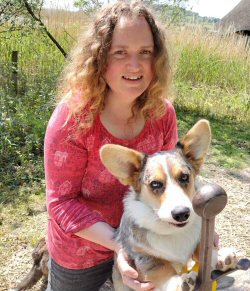 Anneka
Burek fell in love with Cardigan Welsh Corgis after reading on a forum several
amusing posts about them that had her in stitches. The breed is highly
intelligent, loyal and on average, very much a one person dog. With stocky
bodies and little legs, they were bred to herd cattle. It's their character
which attracts people to them as they are pure comedians when they want to be. Anneka got Atlas, her third Cardigan Welsh Corgi, with the intention of doing
dog sports with him. Anneka
Burek fell in love with Cardigan Welsh Corgis after reading on a forum several
amusing posts about them that had her in stitches. The breed is highly
intelligent, loyal and on average, very much a one person dog. With stocky
bodies and little legs, they were bred to herd cattle. It's their character
which attracts people to them as they are pure comedians when they want to be. Anneka got Atlas, her third Cardigan Welsh Corgi, with the intention of doing
dog sports with him.
I dabbled in agility with my first two Cardigans, but it was more
for fun, and we didn't compete.
Atlas was the only
blue merle with tan points in his litter. All the pups were big, chunky and
confident so I knew they were well cared for. I wanted a male pup and was
instantly drawn to him, but first I asked the breeder to confirm that he would
be suitable for doing dog agility. I was pleasantly surprised when he reserved
him for me a few days later as I hadn't asked for it or paid a deposit.
As a puppy he was exactly
what I wanted. He picked things up very fast and enjoyed doing all the
activities that we embarked on together. He is cheeky and always has the last
say. He reminds me so much of my first Cardigan. Her dad is his great
grandfather which was another reason I chose a dog from this litter. Her name
was Isis and, as I wanted to use their names to emphasise the connection, I
stuck with the Greek/Roman mythology theme.
Despite weighing 20kg,
Atlas is still very puppy-like and loves to play and be chased. His favourite
toy varies every day and is currently a sheepskin tug but tomorrow it will
probably be a plastic bottle! He
got his nickname 'Mini Malinois' based on his determination to get the toy no
matter what.
There was one time in class when he
managed to grab the top of my trousers and pull them down which resulted in
everyone seeing more than they had bargained for!
For a while, he resembled a bite sport dog, hanging off my coat
because he wanted the toy so badly. Thankfully that phase - for the most part -
has passed so I possess fewer clothes with holes!
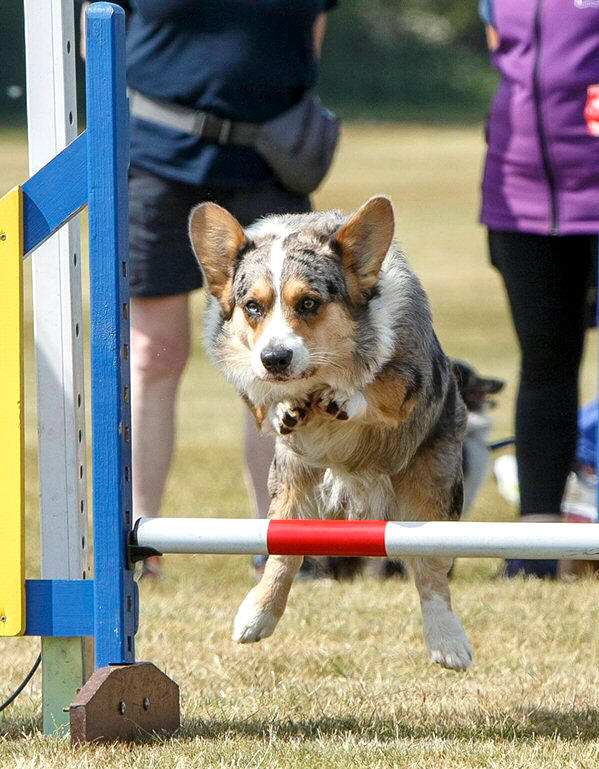 Our
journey Our
journey
I was interested in doing agility but knew we would have to wait
for growth plates to mature, so I decided to look into other training options
that could be done straightaway. We tried a few different activities before
deciding that hoopers was the most fun for both of us. I soon realised what a
driven pup I had once we started using his toys as a reward.
When he was 18 months old,
we started agility lessons on a 1-2-1 basis with a local trainer. He learned all
the equipment, but he naturally gravitated towards the jumps thanks to his early
start with hoopers.
For a while, he was apprehensive about the dog walk which we put
down to being a height issue so we kept it on a lower height and used a lot of
praise when he approached it. Being a toy junkie helped as he would chase the
toy off the end before realising there were no trolls under the bridge. Soon he became
confident enough to complete the whole obstacle. It is now his favourite.
The A-frame was easier. Owing to his natural nosey tendency, he
used it as a viewing platform to see what was going on in the world from a high
perspective. In comparison, we took the seesaw more slowly, lowering it down
gradually every week so that he would gain confidence.
We had reached the stage
of being able to use the contacts as rewards. He would protest about repeating a
set of jumps, to to motivate him, we would ask him to do a sequence with dogwalk
or A-frame at the end as a treat.
The training sessions took place outdoors every week in all
weathers and in a venue which varied from a sand pit in the winter to a field in
the summer. Interestingly, he was fine with the dog walk in the field but, when
it got moved to the sandpit in the winter, we had to retrain it as he'd clearly
never seen it before!
This highlighted the need for me to teach him how to generalise,
as we'd reached a stage of being able to use contacts as rewards. He would
protest about doing a repeated set of jumps, so to motivate him, ask him for the
sequence and then get him to do the dog walk or A-frame at the end.
After some success at training, I decided to enter a few shows.
However, he refused most of the obstacles because, surely, we were just here to
do zoomies and have a good time! He's not wrong to be fair!
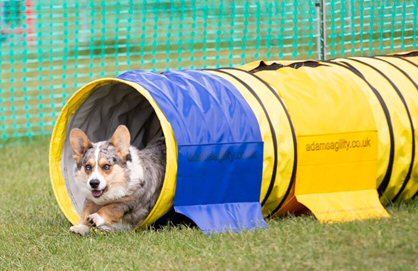 We've
done numerous hoopers shows with success so I knew he had the experience and
drive to get there, but we would have to retrain all the obstacles in different
environments. We've
done numerous hoopers shows with success so I knew he had the experience and
drive to get there, but we would have to retrain all the obstacles in different
environments.
Roll on to today
We've been to the majority of the local agility trainers for 1-2-1 sessions so
he has built confidence on all different brands and types of equipment. He's
also done training days and workshops locally. We are still very much in the
learning stage, and he's an absolute joy to train.
Throughout our training experience we have always had the novelty
factor. People would say 'You don't see many of those' or 'My nan used to have
one' or 'I didn't know Corgis could do sports,' amongst many other Corgi bingo
quotes.
I think the fact that Atlas shows mostly determination and a
willingness to please proves that any dog which is physically and mentally
capable will have fun doing sports with their person.
Adventures with a Corgi
Our
current challenges involve trying to keep him focused when other dogs are
running and keeping him motivated. Sometimes he looks at me as if to say 'make
me' and the expensive sheepskin or fur toys are just not cutting it. However,
get a plastic bottle out and it's a game changer!
He's taught me a lot about motivation in dogs and how to use what
they want as opposed to what we think they should have. My previous dogs were
all food motivated so I never had to consider other rewards. For him, I've used pieces of
carpet from an equine arena before to get him moving as that was something he
was interested in. I've also used sticks if we are out in a field when he's lost
interest in his usual suitcase of toys. Frozen cheese or hotdog is another
favourite motivation as being frozen, especially on a hot day, makes it far more
exciting!
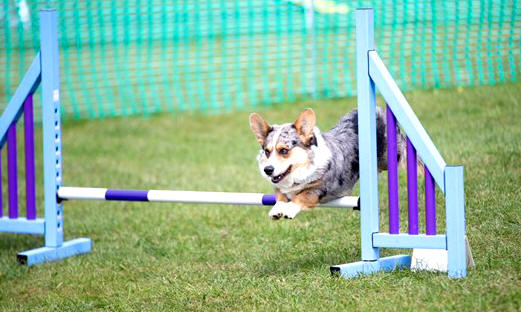 His
biggest reward is scent. I haven't reached the stage of following dogs around
with a pee pot.... yet. I can't imagine trying to explain to a ring party that
the test tube I have in my pocket actually contains another dog's wee and no, I
don't work in the veterinary field. I'm pretty sure he'd surpass his personal
best for that reward though! His
biggest reward is scent. I haven't reached the stage of following dogs around
with a pee pot.... yet. I can't imagine trying to explain to a ring party that
the test tube I have in my pocket actually contains another dog's wee and no, I
don't work in the veterinary field. I'm pretty sure he'd surpass his personal
best for that reward though!
Atlas is now 2.5 years old and has been competing in hoopers since 2024. 2025 is
our first year of competing in agility. He measures Small and we are currently
Grade 1
We are
focusing on local shows this year so it is a mix of KC and independent shows.
To
date, I've not seen any other Corgis at shows or training, but I'm told that
they are out there and I know that the breed is very successful in America.
Why a Corgi?
The breed is known for its
energy and athleticism despite having short legs. They have a natural herding
instinct and are highly intelligent so are well-suited to agility training and
competitions. As quick learners, they pick up commands easily and are keen to
please. Their small size and low centre of gravity work to their advantage
allowing them to manoeuvre around the obstacles with ease.
They are bigger and
stockier than their cousin the Pembroke Corgi, the late Queen's favourite and
come in a wide range of accepted colours with rounder ears, massive paws and
always a tail. Personality-wise they can be clowns but can be a bit more
reserved with strangers but make good watchdogs with their loud bark!
So if
you are trying to get away from barky dogs and want a dog hair-free caravan,
then my advice is just to admire this breed from afar.
If something in this story has made you add this breed to your
shortlist and you'd like to know more about the Cardigan Welsh Corgi, there is a
breed club website.
Cardigans only had 81 litters registered last
year which is worrying as they are such a great breed that it would be a shame
for the numbers to dwindle further. Alternatively, you could look up one of the other vulnerable native breeds
that might have more interest.
If you do north-west shows, you may see us. The only problem with
having a rarer breed is that people remember your runs!
Special thanks
I'd like to thank Barking
Mad Dog Services for their support on our hoopers journey and Dogz Squad for
their help and patience with agility. Thanks to all the local trainers who we have
seen for extra sessions as well as anyone involved in putting on shows that
we've taken part in.
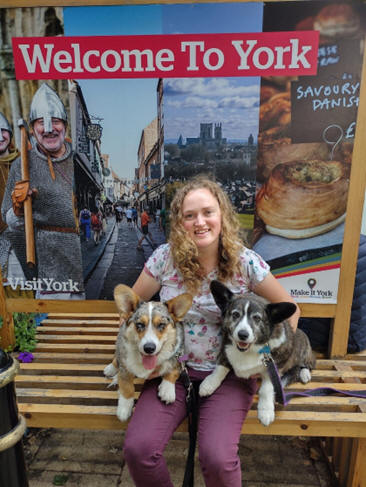 About
the author... About
the author...
Anneka Burek has
been obsessed with dogs ever since she was a
child. One of her fondest memories is of going to Discover Dogs at Crufts at
approximately seven years old, taking a leaflet from every stand for each breed
and then spending her weekends revising all the different dog breeds! It didn't
take her long to learn them all.
She grew up in Chester
in a house which overlooked a meadow with a public footpath, where she could
look out for dogs and try to work out their breeds from afar. Hers was not a dog
family, so she had to beg for her
first dog. Dylan, a Bichon Frise, entered her life shortly after her first
Crufts visit.
Anneka's day job is not
dog-related. She works in the Supplies Department of an NHS hospital which
enables her to put her dogs first and pays for all her dog activities. She
admitted that the reason she chose her current job was because it was across the
road from her house which would allow her to pop home at
lunch to see the dogs and let them out. A 4pm finish means she has a lot of
hobbies after work both dog-related and non-dog-related.
Photo credits: Lisa Harvey - Tunnel and Purple Jump & Jackie
Burrell - Jump with red + white pole
First published 30th June 2025
|